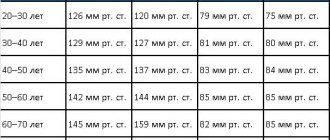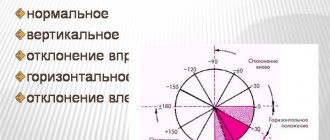When the pressure is 140 over 80 or 140 over 85 mmHg. Art. occurs only occasionally, for example, after experiencing stress or intense physical activity, and the rest of the time it remains at a normal level, there is no cause for concern. But if such indicators become commonplace, we can talk about the beginning of the development of systolic hypertension, the so-called borderline hypertension, which can and should be fought. The list of effective control methods includes the following: taking antihypertensive pills, folk recipes for stabilizing blood pressure, nutritional correction, timely treatment of concomitant diseases.
Two health indicators
The circulatory system is the main transport channel through which a multicomponent fluid circulates, carrying all substances important for the functionality of organs and systems. One of the indicators of the proper functioning of this system, which is branched throughout the body, is blood pressure, or, in medical terms, blood pressure. It is determined by the volume of blood that passes through the heart in a specific period of time, and the resistance provided by the walls of the blood vessels.
As everyone knows from the school course on the anatomy of the human body, blood moves through the bloodstream due to contractions of the heart muscle. This means that the maximum value of blood pressure will be at the exit of the left ventricle of the heart, and the lowest - in the right atrium. It is noteworthy that the blood pressure on the vessels at the exit from the heart and in large arteries remains virtually unchanged - it decreases by 5-10 mmHg. Art. It is also practically stable when blood flows through the veins and in the right atrium. But the change in the force with which the blood acts on the walls of blood vessels occurs in the small vessels of the circulatory system - in arterioles, venules and capillaries, where the blood releases useful substances, taking away everything unnecessary to send for disposal.
The blood pressure at the exit of the heart is called systolic, in common parlance - upper. It is determined by the force with which the heart muscle contracts at a given moment, the resistance of the walls of the aorta and arteries, as well as the number (frequency) of heartbeats (HR) per unit of time. After compression and pushing of blood along the bloodstream, the heart receives a short respite; it is at this moment that the diastolic, or lower, pressure is recorded. Its main component is peripheral blood vessel resistance. As blood moves from the heart to the capillaries and other smallest elements of the blood flow, the difference in fluctuations (amplitude) of blood pressure decreases significantly, and when it reaches the veins, this indicator is practically independent of heart contractions.
According to many years of observations and research, the ratio of the upper and lower levels of blood pressure of a healthy person will be normal if it is recorded as 120/80 mmHg. Art. In the classical norm of blood pressure, the difference between the indicators should be 30-35 mm Hg. Art. And then a logical question arises: if the pressure is measured at 135/80, what does this mean? In this case, the difference between the upper and lower pressure is 55 units. Such a difference should be an incentive to examine the patient's health status. But if you understand the functioning of the circulatory system and the factors influencing blood pressure, then the norm may be a pressure of 135 over 80. What to do to prevent the development or identify existing health problems that require medical attention? Naturally, consult a doctor and undergo a medical examination.
How to determine the standard working pressure?
It is also necessary to follow the rules for measuring blood pressure so as not to make mistakes in its indicators. The diagnosis must be carried out in a calm, relaxed state. Emotional experiences, taking certain foods and medications, and physical activity can affect blood pressure levels.
If blood pressure frequently deviates from the norm, especially in the presence of other warning symptoms, it is recommended to carry out regular monitoring to determine the working blood pressure of a particular person.
To do this, blood pressure measurements should be taken daily, in various situations: while awake and immediately after waking up, at rest and after physical activity, in a relaxed state and after stressful situations, or experienced intense emotions.
The information obtained is entered into a special diary, which is then provided to the attending physician. Based on this information, in combination with the results of urine and blood tests, the doctor will be able to accurately assess the patient’s condition, give him the correct diagnosis and decide on further treatment tactics.
Blood pressure readings should be recorded daily at different times of the day.
Symptoms of blood pressure disorders
Any changes in the normal functioning of the organs and systems of the human body entail certain changes in well-being. Only a specialist can figure out what pathology the symptom that appears indicates. After all, some health or well-being disorders do not cause a person any significant concern. What do those people who have a blood pressure of 135 over 80 complain about? “Have a headache, feel tired or run down,” they say. But a visit to the doctor is postponed, because daily stress, constant busyness at work and household chores become habitual, and such minor changes in well-being, it seems, are easier to relieve by taking medications or simply resting.
But unfortunately, fluctuations in blood pressure can be a symptom of serious health problems. Most often, headaches, anxiety, nausea, and dizziness indicate that blood pressure has changed. Consulting a doctor in these cases will help differentiate the problem and get quality help in solving it. Many people believe that a blood pressure of 135/80 indicates normal cardiovascular health and does not require any intervention to correct it. But often this is only the initial stage of hypertension, and it is at this time that it is best to take preventive measures to prevent its further development.
Symptoms
For hypertensive patients, such a slight increase in blood pressure does not create unpleasant sensations. But in hypotensive patients it can cause the following conditions:
Why does blood pressure increase?
- dyspnea;
- headache;
- dizziness;
- attacks of nausea, vomiting;
- angina attack;
- tachycardia;
- numbness of the tongue, arms and legs.
There is a serious danger when blood pressure increases to a level of 130/80 only for hypotensive patients. Sudden changes in pressure when the blood vessels are in poor condition can cause their rupture, which is accompanied by hemorrhages of varying severity. It is also possible that blood vessels become blocked when atherosclerotic plaques rupture, which leads to the development of heart attacks and strokes.
Increased upper
Cardiac, that is, systolic pressure, defined as the upper pressure, indicates the force with which the blood ejected by the heart presses on the walls of the aorta and large arteries. It has already been proven that with age this indicator changes upward, but still the maximum norms for this value of heart function should remain within 120 mm Hg. Art.
Many people ask: is an upper pressure of 135 units considered something pathological, or can it be the norm in certain situations? To answer this question, you need to understand why systolic pressure increases. The main reason is the pathology of the functionality or condition of the heart and aorta. Thickening of the walls of these components of the cardiovascular system, spasm due to hormonal imbalance, for example in a stressful situation, force the heart to work harder. If this situation becomes chronic, it can cause the development of hypertension, hypertensive crisis, stroke or heart attack. Blood pressure of 135/80 in itself is unlikely to cause such a serious exacerbation of the health condition, but as a predetermining factor requiring the attention of a specialist, examination and quality care, it should be taken into account.
Lowered lower
For an ordinary person who does not suffer from fluctuations in blood pressure, in most cases the upper - systolic - indicator is considered important. But as an indicator of the work and condition of the cardiovascular system, the lower - diastolic - pressure is no less significant. It is characterized by a moment of rest, so to speak, of the heart during the period when the blood, having reached the peripheral small vessels, returns back. Diastolic pressure is determined by the resistance of the capillary system. And if the norm is considered to be a lower pressure of 80 mm Hg. Art., then the question arises: 135/77 - is the pressure normal or not? A decrease in diastolic pressure below normal indicates some pathology of the vascular system, which can cause serious health problems. Today, the World Health Organization sets the normal level of diastolic pressure for an adult from 60 to 90 mm Hg. Art. Therefore, if we consider the state of the cardiovascular system in terms of diastole, then a pressure of 135 over 80 is normal.
healthy difference
As discussed above, blood pressure, which is measured using a special device at a doctor’s appointment or at home, is determined by two parameters - the upper (cardiac) systolic and the lower (vascular) diastolic. Those who have to monitor these indicators are interested in the question of whether a pressure of 135/83 can be considered normal. The answer to this question can only be given by the attending physician who observes a specific patient and records the state of his health over time. Also, in certain cases, it is important for the doctor to monitor the difference between the recorded upper and lower values, which is called “pulse pressure”. Doctors have found that for a healthy person, the difference in systolic and diastolic effects on blood vessels can be from 30 to 50 units. A change in pulse pressure in any direction should prompt a thorough examination. If you follow the norms, then the pressure will be pathological 135 over 80. Reviews from patients with such indicators indicate that in some cases a person’s well-being is not affected by an increase or decrease in blood pressure, but his cardiovascular system suffers.
What is blood pressure
In short, blood pressure numbers are a reflection of the force of the blood’s influence on the walls of blood vessels and the intensity of the work of the heart muscle (myocardium). Cardiologists believe that a pressure of 130 over 80 (130 over 85, 133 over 80, 135 over 80) is not a reason to worry.
Such indicators are considered the norm, but only for a healthy person. For a hypotensive person with a “working” blood pressure of 100/60, such an increase may indicate the development of pathology. Such blood pressure is considered slightly elevated and is defined as an acceptable norm if the person does not have a headache and feels normal.
Baby's blood pressure
A newborn baby is undoubtedly a great happiness for young parents and the baby’s new relatives. Parents and doctors begin to take care of the baby’s health literally from the very moment pregnancy is diagnosed. But the moment of birth and the newborn period, which lasts 2 weeks, require special attention to the condition of the tiny person.
For children of this age, normal blood pressure is considered to be from 60 to 96 for upper systolic pressure and from 40 to 50 for diastolic pressure. When a baby cries, in this way he notifies others about the discomfort or pain he is experiencing at the moment. Crying can cause a temporary increase in blood pressure. In an infant, due to the structural characteristics of the skull bones, often when crying or for some other reason, the fontanel appears to bulge due to increased intracranial pressure. It should be remembered here that intracranial pressure is caused by an excess of cerebrospinal fluid, tissue fluid and blood, compressing the brain. This condition is often not associated with blood pressure, but is caused by other pathologies, congenital or acquired. Therefore, visual changes in the structure of the skull, bulging of the fontanelle, which parents may notice, require a thorough examination by a neonatologist or pediatrician.
But a child’s blood pressure measured at 135/80 indicates a pathological state of the cardiovascular or any other systems, for example, endocrine, nervous, which also suggests an early request for medical help. The period of infancy and early childhood, lasting from 3 weeks to 2 years, is characterized by normal blood pressure in the range of 90-112 for the upper level and 50-74 for the lower level. Any deviations from the norm require diagnostics of the state of the body and the health of the child.
Functionality of the cardiovascular system in a child
The baby is growing, his body is developing, which means significant changes are taking place in the functioning of all his organs and systems. This is also reflected in blood pressure, which is typical for a person during childhood. At the age of 2-3 years, for both boys and girls, systolic pressure should be in the range of 100-112 mmHg. Art., and diastolic - 60-75 mm Hg. Art. The lowest blood pressure is normally recorded in young children. This is due to the structural features of the vascular wall - the tissues are still elastic and easily adapt to minor changes in the operation of the system. Therefore, a pressure of 135/80 regularly recorded in a young child indicates problems in the body that require a thorough medical examination.
For this age group, the most common cause of arterial hypertension, in addition to the genetic factor, is thrombosis and stenosis of the renal arteries, as well as a malformation of this paired organ. In such children, examination often reveals bronchopulmonary dysplasia or childhood-type coarctation of the aorta. Therefore, regular monitoring and recording of a child’s blood pressure should be a mandatory procedure. This will help to timely identify disturbances in the functioning of the heart and blood vessels and determine their cause in order to take measures for treatment or correction.
Teen health
Childhood passes and the child enters puberty. Against the background of activation and changes in the functioning of the endocrine system of a teenager’s body, the functionality of many organs and systems changes. And it is from this moment that a person’s gender becomes a largely determining factor in the norm. Blood pressure is one of the main characteristics of the body’s condition, indicating possible disorders that require confirmation through examination. But the period of puberty is characterized by the instability of this indicator, which can change quite significantly during the day and depend on many reasons, ranging from changes in mood to physical activity. In addition, the state of the cardiovascular system is directly affected by excess weight, smoking or drinking alcohol or drugs. And a heart pressure of 135 considered normal in a teenager can rise quite high for these reasons. At the same time, such changes in blood pressure also occur against the background of a genetic predisposition, as well as some systemic diseases, such as diabetes, oncology, and head injuries. Today, experts believe that an upper pressure reading of 135 is normal. In order to prevent any diseases, it is important to record blood pressure in a teenager annually.
Causes of high upper pressure
Adolescents often experience increased systolic blood pressure during the difficult period of puberty. High blood pressure is temporary and returns to normal over time without the help of medications. But if your child encountered a similar problem in adolescence, there is a high probability that by the age of 40 he will become a true hypertensive patient, so his health needs to be monitored especially carefully even after blood pressure has normalized.
The causes of increased upper pressure in elderly cardiologists (over 65 years of age) are associated with the development of atherosclerosis (clogging of blood vessels with cholesterol plaques) and subsequent calcification. In middle-aged men, the disorder is diagnosed due to poor nutrition, heavy physical labor, emotional overload, and bad habits.
Among the common causes of high upper blood pressure against the background of normal lower blood pressure are:
Blood pressure 140 over 90
- heredity;
- decreased vascular elasticity associated with age-related changes or cardiovascular diseases;
- poor diet, rich in salty and fatty foods;
- excess weight;
- physical inactivity;
- brain diseases;
- head injuries;
- decreased levels of magnesium and potassium in the blood;
- hormonal disorders, including in pregnant women;
- constant stress;
- menopause;
- chronic kidney disease;
- diseases of the endocrine system;
- poor ecology in the region of residence.
Adverse habits such as smoking and alcohol abuse have a detrimental effect on blood vessels.
Youth and health
Unfortunately, the reality is that not only older people suffer from hypertension, but also young people, seemingly full of health and vitality. At 20-30 years old, the norm is defined as a blood pressure of 135 over 80. Although a steady increase in blood pressure is recorded in a significant part of the young population. Hypertension in young people can have two types:
- physiological, associated with external factors - stress, physical or mental fatigue. This pressure returns to normal after the root cause is eliminated;
- pathological, associated with disturbances in the functioning of internal organs or body systems, requiring careful examination and treatment to prevent the development of significant complications.
Such seemingly insignificant factors as physical inactivity, constant emotional stress, poor quality food, lack of daily proper rest, become the cause of hypertension in young people. Already at 25-30 years of age, a person can suffer from isolated systolic hypertension. It is diagnosed in cases of chronic increase in upper pressure above 140 mm Hg. Art. with the lower one not more than 90 mm Hg. Art. According to this, a blood pressure of 135/80 indicates normal functioning of the cardiovascular system. A young person’s body is able to quickly correct pressure surges caused by a stressful situation or overwork. Adequate rest and a change in activity can normalize blood pressure. But if changes in the performance of the cardiovascular system occur frequently or remain outside the normal range for a long time, it is necessary to undergo an examination in order to promptly identify the cause of the disturbances and take measures to eliminate and treat them.
Possible causes of high blood pressure
In most cases, the main cause of high blood pressure is hypertension, pathologies of blood vessels, and cardiac diseases.
A provoking factor can be a stressful situation, psycho-emotional shock, accompanied by the release of a large amount of the hormone adrenaline.
Doctors also identify the following possible causes of high blood pressure:
- Inflammatory processes;
- Nephritis;
- Hepatitis (both infectious and non-infectious);
- Liver dysfunction;
- General exhaustion of the body;
- Anemia;
- Avitaminosis;
- Diabetes;
- Tumors of a benign or malignant nature;
- Vegetovascular dystonia;
- Heart failure;
- Significant blood loss;
- Improper diet, lack of proteins and carbohydrates in the daily menu.
The patient’s lifestyle also plays a big role. Overwork or, on the contrary, lack of physical activity, lack of sleep, smoking, and alcohol abuse contribute to an increase in blood pressure.
In a special position
A person’s gender is a determining factor in the functioning of certain systems and organs. In addition, the main functional task of the female body - conception, gestation and birth of a child - is also associated with changes in the functioning of the entire organism as a whole and its individual structures in particular. A blood pressure of 135 during pregnancy is the highest limit of normal. This period is also called the time of hormonal surges, and therefore a woman should closely monitor her well-being and undergo regular examinations by specialists.
Each trimester of pregnancy is characterized by its own blood pressure. Thus, during the first three months, many women experience a decrease in both systolic and diastolic pressure. There is no need to be afraid of this condition; you just need to follow all the recommendations given by the doctor leading the pregnancy. Then the pressure rises and by the third trimester it can become abnormally high, which is considered an indication for urgent hospitalization and even artificial childbirth. The upper limit of normal is considered to be a blood pressure of 135 over 80 during pregnancy. If the measurements record 140/90 mm Hg. Art. and above, a woman needs an early consultation with a gynecologist and, possibly, hospitalization in a medical facility.
The condition of high blood pressure in a woman in the last stages of pregnancy is very dangerous. It is called “pre-eclampsia” and threatens the development of eclampsia, a serious impairment of the health of the woman and child, and even death. A blood pressure of 135 over 80 in a woman expecting the birth of a baby should be a pretext for careful monitoring of her well-being. Usually, a pregnant woman registers early in the pregnancy with a gynecologist in the antenatal clinic, where the specialist managing the pregnancy regularly measures blood pressure, records the results in a card and, together with the results of regular tests, gives recommendations on how to maintain the health of the pregnant woman and the fetus. But measuring blood pressure outside a medical facility, at home, is not difficult: modern devices allow you to independently track this vital indicator at any time with absolute accuracy. And this will help a woman expecting the birth of a child to monitor the condition of her body so that, if necessary, she can immediately consult a doctor, rather than wait for the appointed time for a visit.
Work, stress and problems of an adult
Every person’s life is full of emotional and physical stress, and with age comes more health problems. All this plays a role in well-being and in the functioning of the cardiovascular system. For an adult, the following indicators are considered normal: blood pressure 135 over 80, pulse 60 beats per minute. But unfortunately, with age, blood pressure changes more and more in the direction of increase; the physical condition of the body, lifestyle, and existing diseases play a role in this. As mentioned above, a person’s gender determines many functional characteristics of the body and indicators of its health. So for men and women, the recorded normal blood pressure will be different (see table).
| Age | Women | Men | ||
| HELL | Pulse | HELL | Pulse | |
| 18-29 | 116/72 | 60-87 | 123/76 | 60-80 |
| 30-39 | 120/75 | 62-89 | 126/79 | 62-80 |
| 40-49 | 127/80 | 62-89 | 129/81 | 62-80 |
| 50-59 | 137/84 | 64-95 | 135/83 | 64-95 |
The parameters indicated in the table are the classic norm. But blood pressure, undoubtedly, can have its upper and lower limits of normal. They differ from the average statistical indicators by 5-7 units in either direction. Therefore, for most middle-aged people, the normal pressure will be 135 over 80. Do you have a headache, do you feel weak and tired, or nauseous? Such symptoms must be correlated primarily with the person’s abnormal blood pressure.
How to control the condition
If your blood pressure is constantly elevated or rises periodically, your condition must be monitored at home. A compact automatic or semi-automatic tonometer is best suited for these purposes. Despite the ease of use of these devices, it is necessary to adhere to a number of simple rules that allow you to obtain the most reliable results of measuring blood pressure in both hypertension and hypotension.
- Half an hour to an hour before the measurement, you should not smoke, play sports or other physical activities, drink caffeine-containing drinks, or eat salty, spicy, or fatty foods.
- You should take a comfortable position, sitting in a chair or on a chair with a comfortable back. The arm on which the cuff is being applied should be at heart level, for example, lying on a table.
- While the tonometer is operating, you should not make sudden movements, gesticulate, or talk.
- To obtain the most reliable data, pressure is measured on both hands with an interval of 10 minutes. Large indicators are taken as a basis. Subsequently, measurements can be taken only on the arm on which the blood pressure turned out to be higher.
- All values - systolic, diastolic pressure, heart rate (a pulse of 60–80 beats per minute is considered normal for an adult), measurement time - are recorded in a log, which should be shown to the doctor to make the correct diagnosis.
Important! The accuracy of the measurement depends on the correct choice of cuff. For an adult or teenager, the standard cuff included with the tonometer is suitable. For a child or a person with large hands, it is necessary to purchase an additional pad.
Years of experience and normal blood pressure
It is believed that elderly and senile age are characterized, first of all, by high blood pressure, which, even with fairly high levels, is perceived as something familiar and taken for granted. Yes, to some extent this statement is true, and for older people, blood pressure is considered normal ranging from 151 mm Hg. Art. for systolic and from 91 mm Hg. Art. for diastolic indicators. In this case, blood pressure (BP) 135/80 indicates the possible development of an ischemic stroke. This relationship has been proven by many observations of specialists around the world.
Orthostatic hypotension is also often observed in adulthood, which manifests itself with a sharp change in the position of a person’s body. In this case, a sudden change in blood pressure is fraught with dizziness and falling, which is very dangerous in old age. So, blood pressure regularly recorded in an elderly person below 135/80 should be a reason to visit a doctor to prescribe pressure-correcting therapy.
It is also necessary to monitor pulse pressure in an elderly person. A large gap between systolic and diastolic readings indicates the inability of the heart muscle to pump blood as needed. A stable pressure of 135 over 80 or 10-15 units more is the norm for a person over 59 years old.
What can help normalize blood pressure?
Blood pressure is one of the main characteristics of the well-being and state of the body at a particular point in time. It changes depending on various everyday situations, the time of day, as well as the state of human health. Stably observed certain indicators of upper and lower pressure require contacting a specialist for examination and prescribing treatment if necessary.
Many of those who monitor their blood pressure or the pressure of relatives are interested in the question: is it necessary to bring down the pressure of 135 to 80? It is impossible to answer this unequivocally. After all, age standards are very different, and the answer will depend primarily on the age of the person whose pressure is measured. So, for a small child such indicators will be too high, which indicates hypertension, but for a person over 61-69 years old this will already be hypotension, which requires mandatory adjustment with the use of medications or traditional medicine recommended by the attending physician if they feel unwell.
Blood pressure is traditionally corrected with homemade and everyday drinks such as strong tea and coffee. They contain caffeine, which helps stimulate vascular tone and increases heart rate. But this effect of tea and coffee does not occur in every case; for some people, these drinks, on the contrary, have a calming and even hypnotic effect. Leisurely walks in the fresh air and a calm atmosphere in the family help normalize blood pressure.
Self-treatment of hyper- or hypotension is not recommended. If necessary, you need to regulate blood pressure only with the means recommended by your doctor. In no case should you use the advice of relatives or friends who have tried “miracle” pills or remedies, because treatment must take into account the characteristics of the person’s body, his age and existing diseases. As you can see, for most adults, a pressure of 135 over 80 is normal. Undoubtedly, this is an average indicator of the functioning of the cardiovascular system, which may vary slightly during the day due to stress, certain foods, and life situations. But prolonged or too frequent changes in blood pressure become a reason for examination, because often high or low blood pressure is a sign of dangerous health problems that require the use of medical care and special medications.
Today, monitoring blood pressure and heart rate is quite simple. In any pharmacy you can purchase a special device - a tonometer, easy to use and understand the information read, which even an elderly person can work independently.
Treatment
Treatment and selection of drugs should be carried out by a qualified specialist. Therapy involves not only taking medications, but also adjusting your diet.
Drugs
Most often, the following groups of medications are prescribed:
- ACE inhibitors – prevent vascular stenosis;
- diuretics - necessary to remove excess fluid from the body and reduce the volume of circulating blood;
- beta blockers - improve the functioning of the heart muscle, protect the myocardium from the negative effects of hormones;
- sartans – relieve vascular spasms and quickly stabilize blood pressure.
Nutrition
To normalize blood pressure levels and return them to physiological norms, it is necessary to review a person’s diet. It is necessary to exclude spicy and fatty dishes/foods, coffee, strong black tea, alcohol of any strength, and sweets from the menu. Fresh berries, fruits, vegetables, cottage cheese, green tea, and cereals will benefit.
Exercise stress
A blood pressure of 130/80 is considered slightly elevated. To stabilize the indicator, doctors recommend swimming. This sport helps strengthen the muscle corset, improves blood circulation, and helps with weight loss.
Water aerobics classes are one of the options for physical activity that allows you to stabilize blood pressure levels.
Shows good results:
- water aerobics;
- long walks in the fresh air;
- regular morning exercises;
- Eastern dance;
- yoga;
- easy running;
- Pilates.
Important! You can use an exercise bike or treadmill, but don't do it too hard.
Folk remedies
To improve your well-being and stabilize blood pressure, you can use traditional medicine recipes.
- In mineral water without gases (250 ml), stir honey (1 tbsp.) and juice from ½ lemon. Drink in the morning before breakfast.
- Combine beet juice (400 ml), lemon juice (from 1 fruit), cranberry juice (1.5 cups), liquid honey (250 ml) and the same amount of vodka. Mix the ingredients and take 1 tbsp. l. means 60 minutes before meals three times a day.
- Mix rose hips (3 tbsp), currants (2 tbsp), chopped nettles (1 tbsp), red rowan (2 tbsp). Place the mix in a thermos and pour boiling water (1 l). Leave for 4 hours. Filter and take ½ cup warm 30 minutes after eating.
Since older people do not tolerate a decrease in blood pressure to the level of 130/80, it needs to be increased. Chinese lemongrass, ginseng, and eleutherococcus can be used as stimulants. While taking stimulant medications, it is necessary to monitor blood pressure readings.











